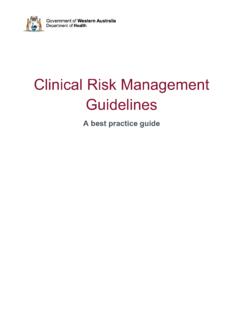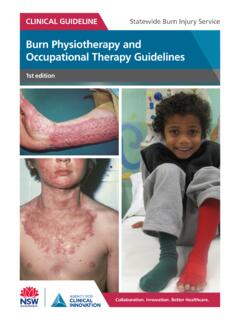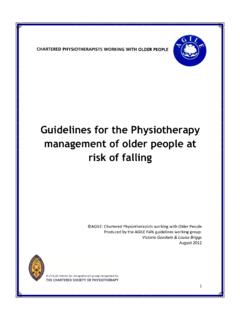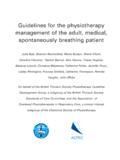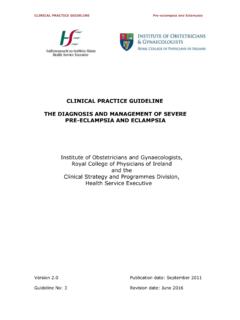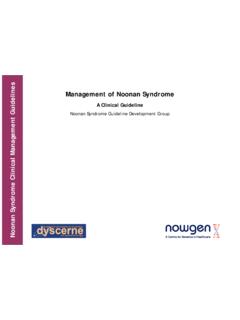Transcription of Clinical guidelines for the pre and post operative ...
1 Clinical guidelines for the pre and post operative physiotherapy management of adults with lower limb amputations2nd Edition- 2016 British Association of Chartered Physiotherapists in Amputee RehabilitationNICE has accredited the process used by the British Association of Chartered Physiotherapists in Amputee Rehabilitation Accreditation is valid for 5 years from 10 January 2017 and is applicable to the guideline processes described in Clinical guidelines for the pre and post- operative physiotherapy management of adults with lower limb amputations . BACPAR Clinical guideline (2016) Amputee rehabilitationClinical guidelines for the pre and post operative physiotherapymanagement of adults with lower limb amputationsAbout this document: This document presents the updated, evidence based, Clinical guidelines for the pre and post operative physiotherapy management of adults with lower limb amputations as described in the literature and expert document will update: Broomhead P, Dawes D, Hancock A, Unia P, Blundell A, Davies V (2006).
2 Clinical guidelines for the pre and post- operative physiotherapy management of adults with lower limb amputations . Chartered Society of physiotherapy , refer to the guideline process document for full details of all methodology and processes undertaken in the development of these recommendations. All appendices referred to will be found in the process this document: Smith S, Pursey H, Jones A, Baker H, Springate G, Randell T, Moloney C, Hancock A, Newcombe L, Shaw C, Rose A, Slack H, Norman C. (2016). Clinical guidelines for the pre and post- operative physiotherapy management of adults with lower limb amputations . 2nd Edition. Available at BACPAR: The British Association of Chartered Physiotherapists in Amputee Rehabilitation (BACPAR) is a professional network recognised by the Chartered Society of physiotherapy (CSP).
3 BACPAR aims to promote best practice in the field of amputee and prosthetic rehabilitation, through evidence and education, for the benefit of patients and the on these guidelines and the additional documents should be sent to:Sara Smith, BACPAR guidelines Coordinator, Douglas Bader Rehabilitation Centre, Queen Mary s Hospital, Roehampton, London, SW15 5PN IntroductionThe first edition of this guideline was published in 2006. This second edition seeks to integrate new scientific evidence and current best practice into the original recommendations and create additional recommendations where new evidence has guidelines are not mandatory and BACPAR recognises that local resources, clinician enthusiasm and effort, support from higher management , as well as the rehabilitation environment in which the practitioner works, will influence the ability to implement recommendations into Clinical practice.
4 CPD activities:Examples of CPD activities and evidence can be found at Health Professions Council (2010) Continuing Professional Development & your registration. Guideline recommendationsThe guidelines are divided into six sections for ease of reference:1. The role of the physiotherapist within the MDT2. Knowledge3. Assessment4. Patient and carer information5. Pre operative management6. Post operative managementEach section includes an introduction, a summary of the evidence, the relevant recommendations and good practice points (GPPs).Throughout these sections the adults with lower limb amputation may be referred to as individuals, amputees, patients or were developed and graded according to the level of evidence (Appendix 8).
5 After each recommendation the letter in brackets refers to the evidence grade allocated (Appendix 13).Where a number of different evidence sources were used to develop a recommendation, the grade is based on the highest level of evidence used. This grade reflects the quality of the evidence reviewed and should not be interpreted as the recommendation s Clinical table of the papers utilised in developing the recommendations and their allocated level of evidence is in Appendix full list of references follows the recommendations. Key to the guideline update:Where recommendations have been amended or added for this update symbols are displayed next to the recommendation numbering for ease of recommendations in this guideline update are marked **.
6 Amended recommendations are marked ~~.BACPAR Clinical guideline (2016) Amputee rehabilitationClinical guidelines for the pre and post operative physiotherapymanagement of adults with lower limb amputationsSection 1 - the role of the physiotherapist within the multidisciplinary teamIntroduction A specialist multidisciplinary team (MDT) achieves the best rehabilitation outcome.(38, 39, 40) To provide an effective and efficient service the team work together towards goals agreed with the patient. The physiotherapist plays a key role in coordinating patient rehabilitation.(41)The Chartered Society of physiotherapy (CSP) Core Standards(2) outline the role of the physiotherapist within an MDT. These standards emphasise the need for physiotherapists to be aware of the roles of other members of the MDT and to have clear protocols and channels of referral and communication between rehabilitate people who have had an amputation, the core MDT may include: specialist physiotherapist, specialist occupational therapist, surgeon, specialist nurse and social worker.
7 Additional MDT members include: diabetic team, dietician, general practitioner, specialist nurses, housing and home adaptation officer, podiatrist, counsellor, psychologist, social services team, social worker, pain control team, wheelchair services, rehabilitation consultant prosthetist, orthotist and community multidisciplinary team approach to rehabilitation following amputation is recognised internationally as the rehabilitation mode of choice; however there is little published literature to support this. Campbell et al(42) concluded from a case series of 61 people with an amputation that the MDT can reasonably predict prosthetic outcome 85% of the time in predicted users and 65% of the time in predicted non users. Ham et al(41), in a case controlled study, suggested that vascular amputees benefit from care by a specialist MDT resulting in reduced hospital stay and out-patient addition to Ham et al(41), two other papers support the role of the physiotherapist within the MDT.
8 Condie et al(43) found that in a cohort of Scottish people with a lower limb amputation, the time from surgery to casting was reduced when the patients received physiotherapy . Klingenstierna(44) concluded from eight case studies that exercise improves thigh muscle strength in people with a transtibial amputation. In the absence of other evidence on the role of the physiotherapist consensus opinion was sought to further inform this section.(45)Recommendations Within the MDT the role of the physiotherapist includes exercise therapy. B(2, 44) Within the MDT the role of the physiotherapist includes assessment and treatment with early walking aids. B(43) The physiotherapist contributes, as part of the MDT, to the prediction of prosthetic use.
9 B(42) A physiotherapist specialised in amputee rehabilitation (Appendix 16) should be responsible for the management of physiotherapy care. C(3, 41) When it is possible to choose the level of amputation the physiotherapist should be consulted in the decision making process regarding the most functional level of amputation for the individual. C(45) The physiotherapist should be involved in producing protocols to be followed by the MDT. C(45) There should be an agreed procedure for communication between the physiotherapist and other members of the MDT. C(45) Within the MDT the role of the physiotherapist includes compression therapy. C(45) A physiotherapist experienced in amputee rehabilitation can, as part of the MDT, be responsible for the decision to start using the early walking aid having liaised with other members of the MDT as necessary.
10 C(45) The physiotherapist, along with other professionals, should contribute in the management of residual limb wound healing. C(45) The physiotherapist, along with other professionals should contribute to the management of pressure care. C(45) The physiotherapist, along with other professionals, should contribute to the management of wound healing on the contra lateral limb if applicable. B(8) The physiotherapist, as part of the MDT, should contribute to the management of pain as necessary. C(45) The physiotherapist, as part of the MDT, should be involved in making the decision to refer the patient for a prosthetic limb. C(45) The physiotherapist should contribute to the decision on which MDT outcome measures are to be used. C(45) The physiotherapist, along with other professionals, should contribute to the patient s psychological adjustment following amputation.
